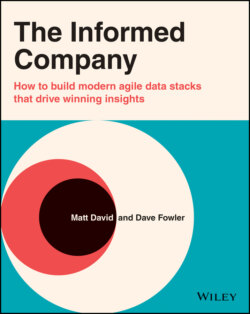Читать книгу The Informed Company - Dave Fowler - Страница 13
Merging Business Context with Data Information
ОглавлениеThere is a chasm between the people who know the technical aspects of how to work with data and the people who know the context behind that data. The technical people can write structured query language (SQL), whereas the business people know which marketing campaigns they've run and what types of users comprise an analysis. This creates friction between the stakeholders who want access to data insights (without always knowing what that data looks like) and the analysts who know their data but not all of its history or significance.
Figure I.1 Business context vs technical know how chart.
A modern data stack seeks to bridge that gap. It enables an organization, not just analysts, to work with data. The modern data stack combines disparate input sources into a single understandable format and then stores that data in a single location that a business intelligence (BI) product can connect to. It should provide the information they need at their fingertips, and it should help everyone ask more questions. The modern data stack should empower teams to organize around a key performance indicator (KPI) and make decisions using data (Figure I.1).
Here are examples of being uninformed versus being informed:
Marketers who keep doubling down on all of their channels versus the ones who iterate or drops them depending on the success and failure of each campaign.
Sales leaders using anecdotes to support what type of customers they should target versus ones who know what customers are coming in and which are closing and can focus their teams accurately on the biggest opportunities.
Support persons who respond to an issue with “what browser are you using?” versus ones who have all of the error information, including the browser details, the account information, and recent actions.
Journalists writing about what matters to them versus ones who can see what resonates.
Product managers who justify their feature by showing the initial results versus ones who set up a test and let the data speak for itself.
Getting data into an understandable format that everyone has access to makes technical and business people collaborators rather than adversaries. It empowers everyone in the organization to make more informed decisions. This book aims to show how to set up a data stack to do just that.
